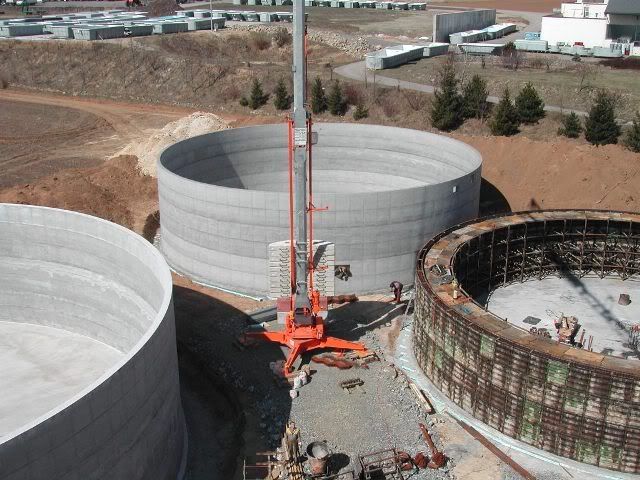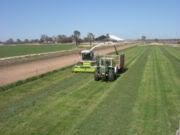Austria builds world's first biogas-based biorefinery; energy and bioproducts from grass
 In a world's first, the government of Upper-Austria (Oberösterreich) and a conglomerate of academic and industrial partners have launched [*.German] the construction of a unique biorefinery in which grass will be converted into biogas and high-value bioproducts. The pilot plant, which is being built in the city of Utzenaich, uses spear-point technologies which are expected to boost Austria's position in the rapidly growing global bioenergy sector and which will cut the country's reliance on petroleum products.
In a world's first, the government of Upper-Austria (Oberösterreich) and a conglomerate of academic and industrial partners have launched [*.German] the construction of a unique biorefinery in which grass will be converted into biogas and high-value bioproducts. The pilot plant, which is being built in the city of Utzenaich, uses spear-point technologies which are expected to boost Austria's position in the rapidly growing global bioenergy sector and which will cut the country's reliance on petroleum products.At the Biopact, we follow biogas developments closely, because they can be easily transferred to the South where biomass feedstocks are abundant (the use of grass makes it especially interesting in this context). Coupling biogas production to green chemistry strengthens the economics of biogas production.
The biorefining processes at the pilot plant involve three steps. Each phase results in a set of product-streams that are direct alternatives for petrochemical products:
- in an initial process, grass is pretreated and chemical compounds are first extracted. Freshly cut grass is dehydrated, a process during which amino-acids and lactic-acid are separated and purified. Both products have industrial uses: amino-acids are used in the pharma-industry, in cosmetics, in the production of protein-rich foods and fodder, and in so-called 'functional food'; lactic-acid is used for the production of desinfectants and solvents and in a variety of food stuffs to act as an acidity regulator; more importantly it can be used as a polymer precursor from which biodegradable plastics can be made.
- the resulting biomass is then used as a biogas feedstock; the biogas will be purified to natural gas quality (90% methane content). The CO2 released during this process is recaptured by the new grass grown in the following cycle, making the process carbon neutral. The purified biogas will then be fed directly into the natural gas grid and used for the production of green electricity and heat, and later on as a transport fuel if advances in the use of Compressed Biogas continue - Austria is experimenting with this.
- in a final step, the sludge that remains after both chemical compounds and energy is extracted from the biomass, will be used as an organic fertilizer (on the new grass stands). This closes the cycle.
 According to project leader Horst Steinmüller (Energie-Institut, University of Linz), there is a global market for the amino-acids and lactic acid produced by the biorefinery, because they are entirely based on non-genetically altered feedstocks. In the US, both compounds are extracted from GM-soja and from hormone treated animal sources. Several markets, especially the Japanese and European market, have banned these compounds. The grass-based alternative is entirely safe, and in the longterm Steinmüller thinks that even bioplastics with a "no-GM" label will catch the competitive advantage.
According to project leader Horst Steinmüller (Energie-Institut, University of Linz), there is a global market for the amino-acids and lactic acid produced by the biorefinery, because they are entirely based on non-genetically altered feedstocks. In the US, both compounds are extracted from GM-soja and from hormone treated animal sources. Several markets, especially the Japanese and European market, have banned these compounds. The grass-based alternative is entirely safe, and in the longterm Steinmüller thinks that even bioplastics with a "no-GM" label will catch the competitive advantage.The €4,6 million project is part of an ambitious bioenergy R&D program launched by Austria in 2000 and which is aimed at lowering the country's dependence on imported fossil fuels. The technologies used in the biorefinery were developed by Joanneum Research (an established authority on bioenergy R&D) and Bio-RefSys, a bioenergy firm, within the framework of a research program called "Factories of the Future". Since 1994, Austria's national industrial R&D agency, the BMVIT, has been working on biorefinery concepts and on processes to feed biogas into the natural gas grid. Up to this day, some €3 million have been invested in over 1,000 projects within the context of the "Factories for the Future" program. The biorefinery is the result of this effort.
This innovative pilot plant is another important step in our energy future and will strengthen our leadership in the sector of renewable energies. With this biorefinery, we also want to launch an offensive aimed at boosting research and development efforts for the production of environmentally friendly solvents and biopolymers. The time has come to take the pole position in this field. - Rudi Anschober, minister for the environment.The project is financed by the national and regional governments of Austria and of Oberösterreich, as well as by a series of industrial partners. The implementation and management of the project is carried out by two state-owned energy companies, Oberösterreichische Ferngas AG and Oberösterreichische Energie AG:
 biomass :: bioenergy :: biofuels :: energy :: sustainability :: petrochemistry :: green chemistry :: biogas :: biorefinery :: grass :: Austria ::
biomass :: bioenergy :: biofuels :: energy :: sustainability :: petrochemistry :: green chemistry :: biogas :: biorefinery :: grass :: Austria :: At a press conference, Eduard Mainoni, Austria's minister for Science and Technology, pointed out that "the technologies and processes used in the biorefinery have been proved to work in the laboratory. Now it is time to test them to see whether they will work on a large-scale and continuously. After two years, we will assess the socio-economics of the project and if viable, we will launch an initiative to promote the technology internationally to strengthen our environmental leadership." If successful, the project will be replicated and bring employment opportunities in a series of sectors.
Regenerating agriculture
The minister for agriculture, Dr. Josef Stockinger: "With this biorefinery we have a chance to revive the stagnant rural economy. Grasses are the raw materials; when they're harvested, the meadows are left to regenerate by themselves." With a decline in meat and milk production, Austria has seen its grasslands becoming unproductive. Studies estimate the hectarage of unused pastures to be between 100,000 and 150,000ha.
Some 500 farmers from the region will harvest grass on 15,000 hectares of land for the production of the two biochemical compounds in ten processing centres.
Towards energy independence
The innovative biorefinery has attracted considerable interest from utilities and energy companies alike, who are reacting to stronger calls from Austrian consumers for clean, renewable bioenergy. "Biogas is a very important renewable energy carrier for the production of heat and electricity, but also for use as a transport fuel. We support the development of technologies that make this energy carrier more competitive", so says Dr Leo Windter, CEO of the Oberösterreichische Energie AG. Both vice-directors of the Oberösterreichische Ferngas AG, Dr Johann Grünberger and Dr. Gerhard Siegl in unison: "Locally produced energy from biomass has a lot of potential. Upper-Austria is literally pumping the gas pedal here."
Austria's state secretary of science and technology thinks the country can aim for energy independence over the long term. "In the coming years, we will strengthen our commitment and increase our funding for research into renewable energies. This is the only way new technologies will be created that might allow us to become independent of foreign energy resources." Mainoni adds: "The use of biogas is a perfect example of this: with increased efforts it will be possible to create our own gas reserves. By feeding biogas into the natural gas grid we will be able to control our own gas consumption and cover our own supplies."
More information:
Oekonews: Grüne Bioraffinerie in OÖ: Österreichische Forschungsergebnisse werden in weltweit erster Pilotanlage umgesetzt - Nov. 21, 2006
Nachrichten: Weltpremiere in Utzenaich: Biogas aus Gras - Nov. 21, 2006
Nachrichten: Gas aus Gras: Biomasse ersetzt Erdöl - Nov. 21, 2006
 -------------------
-------------------
 Spanish company Ferry Group is to invest €42/US$55.2 million in a project for the production of biomass fuel pellets in Bulgaria.
The 3-year project consists of establishing plantations of paulownia trees near the city of Tran. Paulownia is a fast-growing tree used for the commercial production of fuel pellets.
Spanish company Ferry Group is to invest €42/US$55.2 million in a project for the production of biomass fuel pellets in Bulgaria.
The 3-year project consists of establishing plantations of paulownia trees near the city of Tran. Paulownia is a fast-growing tree used for the commercial production of fuel pellets.









0 Comments:
Post a Comment
Links to this post:
Create a Link
<< Home